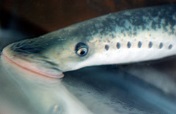National Invasive Species Awareness Week: Sea lamprey
Learn more about the sea lamprey, an aquatic invasive species in Michigan, and what you can do about it.

National Invasive Species Week 2015 is February 22-28. Invasive species are plants, animals and other organisms that are not traditionally found in a given location (in this case the Great Lakes) and create a negative impact of some kind, whether ecological, economic, social and/or a public health threat.
To help celebrate, each day this week Michigan State University Extension is featuring a different aquatic invasive species that has invaded or has the potential to invade Michigan’s environment. Today’s featured aquatic invasive species is the sea lamprey.
Species Name: Sea lamprey (Petromyzonmarinus)
Description: This aquatic invasive species is a parasitic eel-like fish with a circular mouth containing numerous rows of teeth that attach like a suction cup to the exterior of the fish they prey on. They can reach up to 24 inches in length. It is uniquely adapted to live in both salt and fresh water habitats.
Similar species: Chestnut lamprey (Ichthyomyzoncastaneus) and silver lamprey (Ichthyomyzonunicuspis). According to Michigan Sea Grant, you can tell sea lamprey apart from chestnut and silver lamprey by observing the dorsal and caudal fins – the native lampreys have a single dorsal fin continuous with the caudal fin, while Sea Lamprey have a separated dorsal fin and caudal fin.

Origin: Sea lamprey are native to the Atlantic Ocean.
How it came to the Great Lakes: According to Great Lakes Fishery Commission, sea lampreys entered the Great Lakes system in the 1800s through man-made locks and shipping canals. Prior to the Welland Canal being built, Niagara Falls served as a natural barrier to prevent sea lamprey from migrating into Lake Erie and beyond.
How long it has been here: According to Great Lakes Fishery Commission, sea lampreys were first observed in Lake Ontario in the 1830s, and after modifications to the Welland Canal in 1919, Sea Lampreys rapidly spread to the other Great Lakes waterways – Lake Erie in 1921, Lake St. Clair in 1934, Lake Michigan in 1936, Lake Huron in 1937 and Lake Superior in 1938.
Extent of range: Sea lamprey can be found in all major Great Lakes water bodies.
Why it is a problem: The U.S. Geological Survey (USGS) states that a single sea lamprey can kill 40 or more pounds of fish, and were the major cause of the collapse of lake trout, whitefish, and chub populations in the Great Lakes during the 1940’s and 1950’s. Sea lamprey will latch onto a fish and suck its blood until the fish eventually dies.
How it is spread: According to the Minnesota DNR, man-made canals allowed the sea lamprey to bypass natural barriers and spread into the Great Lakes from their original habitats of the Atlantic Ocean and coastal regions.
A cool/unusual fact: For Queen Elizabeth II’s Diamond Jubilee in 2012, chefs imported sea lamprey from the Great Lakes in order to bake a sea lamprey pie, as sea lamprey are an endangered and protected species of the Severn River in England.
Management actions/options: Management agencies have developed a number control options for sea lamprey, including lampricides, barriers, traps, pheromones and alarm clues. The Great Lakes Fish Commission and its partners recommend an integrated control approach that combines several of these options.
What you can do to help prevent the spread:
The Aquatic Nuisance Species Task Force encourages people to learn about sea lamprey, support your governmental agencies that are collaborating to control sea lampreys, and practice general aquatic nuisance species prevention: Do not release aquarium pets or live food into the environment; never dump live fish, e.g. baitbuckets, from one body of water into another body of water; and always drain water from your boat, livewell, and bilge before leaving any water access.
Learn more about how you can help by visiting the Michigan Sea Grant website.
Invasive Species Resources:
- Michigan Sea Grant Sea Lamprey Fact Sheet
- Great Lakes Commission Fact Sheet
- Michigan Invasive Species Information Network smartphone app
- Michigan Natural Features Inventory publications
- Michigan Natural Features Inventory field guide
- Great Lakes Aquatic Nonindigenous Species Information System
- Michigan Department of Natural Resources - Invasive Species



 Print
Print Email
Email




